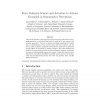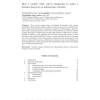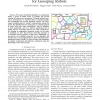IWC
2008
14 years 13 days ago
2008
Science fiction stories seductively portray robots as human. In present reality (early 21st century) robots are machines, even though they can do many things far better than human...
IJRR
2008
14 years 14 days ago
2008
This paper deals with minimum time trajectory optimization along a specified path subject to thermal constraints. We point out here that robots are often integrated in complex rob...
IJRR
2008
14 years 14 days ago
2008
Automatically building maps from sensor data is a necessary and fundamental skill for mobile robots; as a result, considerable research attention has focused on the technical chall...
CORR
2006
Springer
14 years 15 days ago
2006
Springer
This paper presents a coordination algorithm for mobile autonomous robots. Relying upon distributed sensing, the robots achieve rendezvous, that is, they move to a common location....
CONNECTION
2006
14 years 15 days ago
2006
This article describes a developmental system based on information theory implemented on a real robot that learns a model of its own sensory and actuator apparatus. There is no in...
AROBOTS
2006
14 years 15 days ago
2006
All mobile bases suffer from localization errors. Previous approaches to accommodate for localization errors either use external sensors such as lasers or sonars, or use internal s...
AROBOTS
2006
14 years 15 days ago
2006
Most current mobile robots are designed to determine their actions according to their positions. Before making a decision, they need to localize themselves. Thus, their observation...
AI
2006
Springer
14 years 16 days ago
2006
Springer
In this paper we describe a machine learning approach for acquiring a model of a robot behaviour from raw sensor data. We are interested in automating the acquisition of behaviour...
CORR
2008
Springer
14 years 16 days ago
2008
Springer
We study the kinematic geometry of general 3-RPR planar parallel robots with actuated base joints. These robots, while largely overlooked, have simple direct kinematics and large ...
CORR
2010
Springer
14 years 16 days ago
2010
Springer
We propose distributed algorithms to automatically deploy a group of mobile robots to partition and provide coverage of a non-convex environment. To handle arbitrary nonconvex envi...







